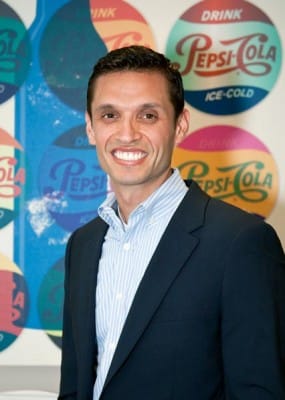
PepsiCo was your first employer and you’re still with the company. What is the appeal?
PepsiCo stood out to me for its vast stable of iconic brands, relentless focus on innovation and growth, and strong track record of developing leaders. I’ve been fortunate to work in a variety of roles with the company including brand marketing, channel marketing, and most recently, multicultural marketing. In 2012, I assumed the role of director of cultural strategy for CSDs, which gives me the opportunity to market our biggest soda brands—Pepsi, Mountain Dew, and Sierra Mist—to multicultural consumers.
The Sierra Mist brand, in particular, has relevance to the Hispanic market. What are some of the multicultural strategies you’ve implemented for the brand?
Marketing research shows that Hispanics will account for the lion’s share of future growth across multiple CSD categories, particularly lemon-lime sodas such as Sierra Mist. That research has directed our entire marketing plan—from our communication, to our packaging and innovation, to how we activate at retail. One example is our partnership with chef Aarón Sánchez, a rising star on the Food Network, who’s relevant to Hispanics, but broadly appeals to the general market as well.
What initiatives has Sánchez been involved in?
We created a series of one minute “webisodes,” or cooking demonstrations, shot in both Spanish and English, and pushed these out in Hispanic and mainstream media outlets, which generated more than 200 million media impressions. Since Hispanics over-index on using their mobile phones to access digital content, we partnered with SocialCam to push out the content and were quickly one of the Top 10 brands on SocialCam.
How do cultural differences come into play when marketing to a Hispanic audience?
In the past, it was assumed that creating Spanish-language ads was enough to reach the Hispanic consumer, but that’s quickly changing. In fact, many Hispanics consume very little Spanish-language media, so we have to ensure our general market creative is relevant to Hispanics, particularly younger consumers. It’s also important to recognize Hispanics don’t behave in a monolithic way. At PepsiCo, our Hispanic segmentation takes into account not just demographics, but also mind-sets such as the importance of image or the role of health, which allows us to finely tune our messages.

What do you enjoy the most about your job?
I find marketing strategy very rewarding—I love the process of taking a wide range of internal and external inputs and distilling them down into insights that guide the
development of a strategic plan. Early in my career I also was advised to not shy away from assignments on struggling brands, and I’ve found these are the roles where I’ve learned the most. When working on a declining business, you’re forced to deconstruct the business and marketplace to develop a strategy that will turn the ship around. It involves risk, but there’s an incredible sense of accomplishment when your plan succeeds.
What advice can you share for up-and-coming marketing professionals?
Embrace change—across all industries, the pace of change is accelerating, and learning to adapt and excel in a dynamic environment is critical to success. Go broad—it’s easy to stick with what you know or where you’re comfortable, but I’ve found going outside of my comfort zone is when I learn the most. Build your network—it takes time and effort, but
it’s a worthwhile investment.
Tell us what’s next for you professionally.
Right now, I’m focused on preparing for two undeniable trends: The growth of
the Hispanic market and the rise of digital and mobile media. Marketing to tomorrow’s multicultural consumers will require totally new approaches in order to break through and be relevant. The work will still be grounded in many of the same principles but activated in different ways and enabled with new technology.

